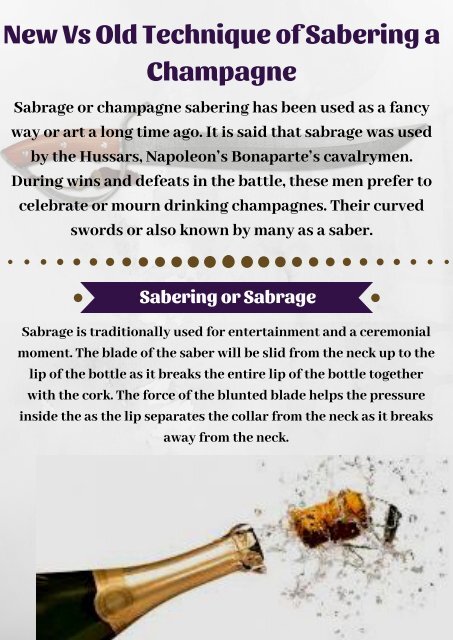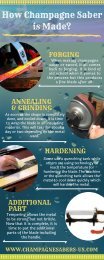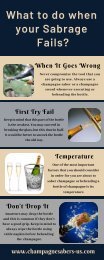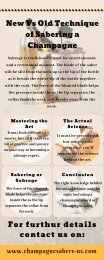Techniques of Mastering The Art of Sabrage with Champagne Saber
It may look difficult to master, but all it takes is a bit of practice and you are on your way to becoming a sabrage expert. Go through our file to learn about the ways to master the art of sabrage by champagne saber.
It may look difficult to master, but all it takes is a bit of practice and you are on your way to becoming a sabrage expert. Go through our file to learn about the ways to master the art of sabrage by champagne saber.
Create successful ePaper yourself
Turn your PDF publications into a flip-book with our unique Google optimized e-Paper software.
New Vs Old Technique <strong>of</strong> <strong>Saber</strong>ing a<br />
<strong>Champagne</strong><br />
<strong>Sabrage</strong> or champagne sabering has been used as a fancy<br />
way or art a long time ago. It is said that sabrage was used<br />
by the Hussars, Napoleon’s Bonaparte’s cavalrymen.<br />
During wins and defeats in the battle, these men prefer to<br />
celebrate or mourn drinking champagnes. <strong>The</strong>ir curved<br />
swords or also known by many as a saber.<br />
<strong>Saber</strong>ing or <strong>Sabrage</strong><br />
<strong>Sabrage</strong> is traditionally used for entertainment and a ceremonial<br />
moment. <strong>The</strong> blade <strong>of</strong> the saber will be slid from the neck up to the<br />
lip <strong>of</strong> the bottle as it breaks the entire lip <strong>of</strong> the bottle together<br />
<strong>with</strong> the cork. <strong>The</strong> force <strong>of</strong> the blunted blade helps the pressure<br />
inside the as the lip separates the collar from the neck as it breaks<br />
away from the neck.
<strong>Mastering</strong> <strong>The</strong> <strong>Art</strong><br />
It may look difficult to master, but all it takes is a bit <strong>of</strong><br />
practice and you are on your way to becoming a sabrage expert.<br />
However, when practicing, it is highly recommended not to use<br />
an ordinary knife or kitchen knife. the blade <strong>of</strong> champagne<br />
sabers or champagne swords are blunt since the art does not<br />
require a sharp blade perfecting the execution.<br />
<strong>The</strong> Actual Science<br />
<strong>The</strong> science behind sabering is not<br />
as complicated as it seems. As you<br />
may already know, champagne is<br />
so bubble for one reason and that<br />
is because <strong>of</strong> the fact that such<br />
wine is fermented <strong>with</strong> sugars that<br />
forms carbon dioxide gas.
It must be performed at a suitable temperature. It must be<br />
served cold, but not too cold otherwise, you’ll jeopardize the<br />
science behind the art. Having it chilled in a bucket full <strong>of</strong> ice<br />
and leave it for about 15 minutes or so will do. You can put<br />
the bottle upside down so the neck will be properly<br />
chilled. before doing so, make sure that you removed the foil<br />
and the cork wire.<br />
Conclusion<br />
Perfecting this new art <strong>of</strong> uncorking, or should I say, an old way<br />
<strong>of</strong> uncorking requires practice, the right knowledge behind the<br />
actual science and the right tool using a champagne sword or<br />
champagne saber. Practice would not make the art perfect since<br />
no one is perfect, but practice can make you better.<br />
For more details contact us on:<br />
www.champagnesabers-us.com















